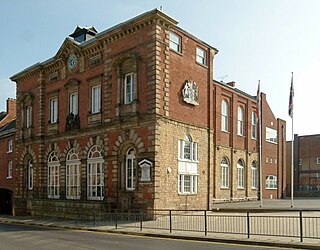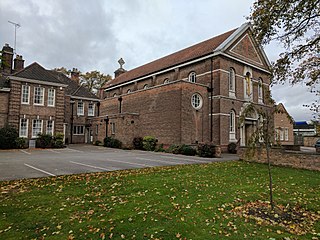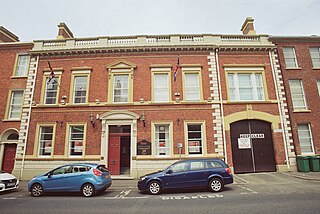
Alfreton is a town and civil parish in the Amber Valley district of Derbyshire, England. The town was formerly a Norman Manor and later an Urban District. The population of the Alfreton parish was 7,971 at the 2011 Census. The villages of Ironville, Riddings, Somercotes and Swanwick were historically part of the Manor and Urban District, and the population including these was 24,476 in 2001.

Mansfield District is a local government district in Nottinghamshire, England. Its council is based in the town of Mansfield. The district is bounded by the districts of Ashfield District, Newark and Sherwood and Gedling. As well as the Derbyshire district of Bolsover District and North East Derbyshire. It is also part of the Mansfield urban area.

Mansfield Woodhouse is a settlement about 1.2 miles (2 km) north of Mansfield in Nottinghamshire, England, along the main A60 road in a wide, low valley between the Rivers Maun and Meden. Founded before the Roman Empire, it is noteworthy for its stone-built centre.

The town of Chesham formed a local government district in the administrative county of Buckinghamshire, England from 1884 to 1974. It was administered as a local government district from 1884 to 1894, and as an urban district from 1894 to 1974.

The city of Ely formed a local government district in the Isle of Ely and Cambridgeshire from 1850 to 1974. It was administered as a local board district from 1850 to 1894, and as an urban district from 1894 to 1974. Unusually for somewhere which claimed city status, Ely was not a municipal borough.

Warsop is a town and civil parish in the Mansfield district, Nottinghamshire, England, on the outskirts of the remnants of Sherwood Forest. At the 2001 census it had a population of 12,365, reducing to 11,999 at the 2011 Census including Church Warsop, Meden Vale and Spion Kop.

Mansfield is a market town and the administrative centre of Mansfield District in Nottinghamshire, England. It is the largest town in the wider Mansfield Urban Area. It gained the Royal Charter of a market town in 1227. The town lies in the Maun Valley, 12 miles (19 km) north of Nottingham and near Sutton-in-Ashfield. Most of the 106,556 population live in the town itself, with Warsop as a secondary centre. Mansfield is the one local authority in Nottinghamshire with a publicly elected mayor.

Mansfield was a municipal borough in Nottinghamshire, England from 1891 to 1974. It was created under the Municipal Corporations Act 1835.

Aylesbury Town Hall is a name which has been used for two different buildings in Aylesbury, Buckinghamshire, England. Since 2007 the name has been used for an office building at 5 Church Street, which serves as the headquarters of Aylesbury Town Council. The name was also formerly used for a complex of buildings which had been built in 1865 as a corn exchange in Market Square, and which served as the offices and meeting place of the local council from 1901 to 1968. The majority of the old town hall was demolished shortly afterwards, leaving only the entrance archway facing Market Square still standing, now called Town Hall Arches. This remaining part of the old town hall is a Grade II* listed building as part of the range of civic buildings on the southern side of Market Square including the old County Hall.

The Old Town Hall is a municipal building in the Market Place in Mansfield, Nottinghamshire, England. The town hall, which was the meeting place of Mansfield District Council, is a Grade II* listed building.

Sookholme is a village and former civil parish, now in the parish of Warsop in the Mansfield district of western Nottinghamshire, England. It is 120 miles (190 km) north west of London, 16+3⁄4 miles (27.0 km) north of the county town and city of Nottingham, and 3+1⁄2 miles (5.6 km) north of the town of Mansfield. It retains an agricultural character, having been largely unaffected by the Industrial Revolution, which had a transformative impact on the settlement pattern and built form of numerous other settlements situated within the North Midlands coalfields. Whilst relatively close to the built up areas of Mansfield and Shirebrook, Sookholme is remote and rural. In 1931 the parish had a population of 210.

Warsop Vale is a small village in the Mansfield district of western Nottinghamshire, England. It is 120 miles (190 km) north west of London, 17+1⁄2 miles (28.2 km) north of the county town and city of Nottingham, and 4+1⁄4 miles (6.8 km) north of the town of Mansfield. It is in the civil parish of Warsop. Warsop Vale's heritage is primarily as a former mining village. It lies in the very picturesque area known as the Dukeries and is easily accessible to Clumber Park, Thoresby Park and hall, Rufford Park and the Earl of Portland estate of Welbeck, together all part of Sherwood Forest.

Worksop Town Hall is a municipal building in Potter Street, Worksop, Nottinghamshire, England. The town hall, which was the headquarters of Worksop Urban District Council, is a Grade II listed building.

Tring Market House is a municipal building in the High Street, Tring, Hertfordshire, England. The structure, which is the meeting place of Tring Town Council, is a Grade II listed building.

Horbury Town Hall is a former municipal building in Westfield Road, Horbury, West Yorkshire, England. The structure, which is now used as business centre, is a locally listed building.

Beeston Town Hall is a municipal building in Foster Avenue in Beeston, Nottinghamshire, England. The building was formerly the offices of Beeston and Stapleford Urban District Council and is now used by the Redeemer Church.

The Old Town Hall, is a former municipal building in Albion Street in Southwick, West Sussex, England. The building, which is now used as offices, was the meeting place of Southwick Urban District Council.

St Philip Neri Church is a Roman Catholic parish church in Mansfield, Nottinghamshire, England. It was founded by Edward Bagshawe, Bishop of Nottingham. It was built from 1924 to 1925 and designed by Charles A. Edeson and was influenced by Brompton Oratory, where Bishop Bagshawe formerly served. It is located on Chesterfield Road South to the north of the town centre. It is in the Italian Baroque style and is a Grade II listed building.

The Old Town Hall is a municipal structure in Castle Street, Lisburn, County Antrim, Northern Ireland. The structure, which is used as a constituency office by the Democratic Unionist Party, is a Grade B2 listed building.




















